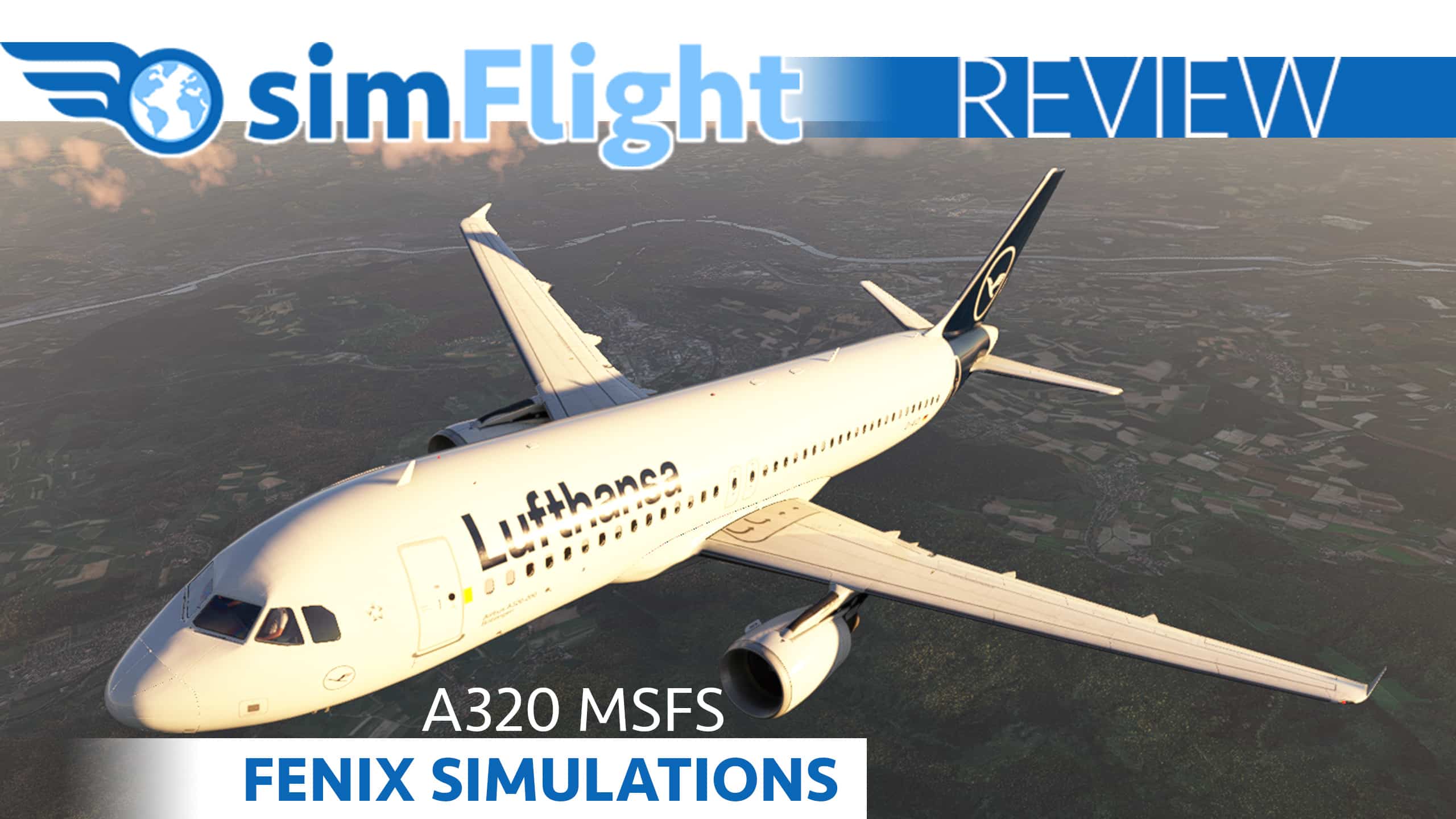
Just under a year ago, the newcomer Fenix Simulations announced an Airbus of such quality that we Flight-Simmers had mouth wide open. Because the scene has a lot of experience with the crash of high-flying announcements, the reactions varied from disbelief to distant mockery to the famous drooling when the screenshots and videos appeared. Fenix kept its word and published the A320 200 CFM on 19 May 2022 – for around 60 Euros! Does the plane live up to its promise? Michael Kalff tested it, Patrick Seiniger looked deeper into the systems.
The Original Model
The A320 is one of the best known and most successful aircraft in the world – anyone who has ever boarded a passenger jet since 1990 has a good chance that it was an A320. In 1981, development began at Airbus to compete with the then dominant B727 and B737 on short and medium haul routes. Air France immediately ordered 25 aircraft and pre-booked a further 25. In 1987 the A320-100 made its maiden flight, already replaced in 1988 by a modified version, the A320-200 for 150 to 180 passengers with more stable wings, larger tanks and the more powerful CFM engines. With more than 260 orders on its first flight, the A320 has meanwhile outstripped the B737: 16,000 orders vs. 15,000 and 10,300 deliveries since 1988 vs.10 .900 deliveries since 1967. More than 9,500 A320s are in active service on all continents with some 540 operators, primarily as passenger jets, but also cargo versions (mainly converted from used passenger jets), VIP jets for governments, military versions as troop transports, medevacs and for surveillance and electronic warfare, civil as research aircraft.
Compared to the A300 and A310, the A320 introduced revolutionary new concepts borrowed from military aviation: fly-by-wire controls with sidestick and six screens (“glass cockpit”) and EFIS, ECAM instead of analogue displays , since 2003 with LCDs instead of CRT monitors. Until the 2010s, pilots and simulators alike were still debating: “Boeing type” or “Airbus type” … the fact that the computer checks the pilot’s inputs for consistency and feasibility and only passes on control commands within defined parameters was initially suspect to many. In the meantime, however, the Airbus philosophy has become widely accepted in civil aviation. Especially since Boeing put shareholder value before safety, and the quality problems there became more frequent, culminating in two catastrophic crashes of the B737 MAX, the A320 has been pulling ahead of its competitor.
The A320 was followed by shorter (A319/1992, A318/2002) and longer (A321/1988) versions of the type. The A330 (1992) and A340 series (1991) also docked on the philosophy and cockpit design of the A320. Since 2016, a renewed variant with more economical, quieter engines has been delivered, the A320neo, which we know so congenially implemented by FlyByWire in the MSFS. The last A320 CEO rolled off the production line in 2021, with a list price of around 100 million dollars.
Such a common aircraft is naturally involved in accidents. In 29 incidents so far, people have died and/or aircraft have been lost, including such dramatic / famous ones as Sullenberger’s ditching in the Hudson River or in 2015 the narcissistic suicide pilot of Germanwings who took 150 people to their deaths. Causes of accidents, especially in the early years, are pilot error (or lack of training) and maintenance errors, less often technical failure or design flaws. However, French authorities are suspected of having influenced accident investigations in order to shift responsibility away from technology and towards pilots, so as not to weaken Airbus’ market opportunities. Incidentally, the 737 recorded 101 such incidents in the same period (i.e. 1988 to 2022)!
In flight simulation, the B737 also initially had the edge … it was also easier to programme because of its more conventional avionics design. Since FS98, a B737 was part of the standard scope of Microsoft Flight Simulator, only in FSX did an Airbus come along (A321), but visually and functionally rather a horror. First iFly and then PMDG brought system-deep 737s for FSX long before anyone dared to pack the seven computers of Airbus’ fly-by-wire system convincingly into Microsoft’s simulator. In the late days of FSX, Aerosoft came up with its after-work Airbuses, which at least made an “airbus-like” impression with realistic cockpits and “abbreviated” systems. FSLabs entered the market with a greater demand for system depth but also three times as expensive, and in P3D still “state of the art” in Airbus simulation. In MSFS 2020 there is again a standard Airbus, which also looks good, but functionally lags behind Aerosoft. By the way, the fact that the 737 fell out of the default spectrum may be due to ASOBO’s French location or the 737MAX disaster. Instead, as already mentioned, the freeware forge FlyByWire programmed an A320NEO, the capabilities of which went beyond Aerosoft’s payware for FSX at the time.
And now Fenix, and at 40% off the price at FSLabs. We like to take a closer look!
Fenix’ Conversion into MSFS
The A320 CFM is available exclusively from Fenix Simulations for about 60 Euros. The installation requires about 5GB of disk space, downloading and installing is no problem at first, links to the livery manager and the configuration program appear on the desktop. Before using the A320 for the first time, you have to configure it according to the hardware you have – this is a really frame-eating plane in MSFS – even with my actually good basic equipment! For computer laymen like me, it is not easy to see through which settings affect the respective system, either by experimenting or by looking for experience reports on the net. Fenix A320 requires a period of familiarization anyway, apart from real Airbus pilots probably nobody flies with it straight away. You can choose from almost 180 liveries (current and historical), install them in 4k or 8k, and there are 300 more on Flightsim.to.
The Walkaround
Good textures are already standard for payware in the MSFS, I never had any complaints in any review. So far, washed-out or pixelated areas have only been seen in the vicinity of cleaning cloths, which is something that simulators don’t really get to do. What Fenix offers us with the A320, however, is “one up” – I catch myself studying the paint from an ant’s perspective, as I do with a car fresh from the car wash, for the sheer pleasure of the mixture of gloss and microstructures (e.g. car wash belts and small stone chips). Anyone who has ever stroked (i.e. washed) aeroplanes knows this as well – and Fenix’s textures are convincing right down to these levels. The only difference is that the weals are from air currents, the marks from insects hitting the wing edges and nose. There are stains too, of course, oil plumes, dirt streaks, weathering … this gives a very, very physical impression of an Airbus, the experience in the simulator has never been so ‘close’.
As an example I take the A320 walkaround at Captain Joe … and please compare yourself: every antenna, every probe, every outlet, every inlet, every marking … every edge, every curvature … is reproduced one to one. Such an Airbus has quite a lot of stuff on its skin … and literally everything is realized. The view into the engines also fits, you almost want to touch the tires. You can literally smell the whole Airbus during the walkaround, it all looks so faithful. Even the small yellow indicator light for the parking brake on the nose landing gear works. W O W. This is simulation 2022!
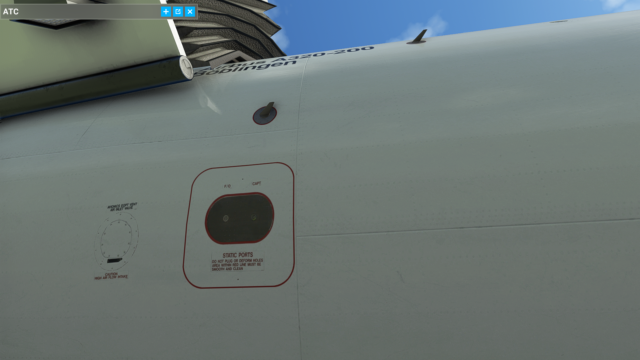
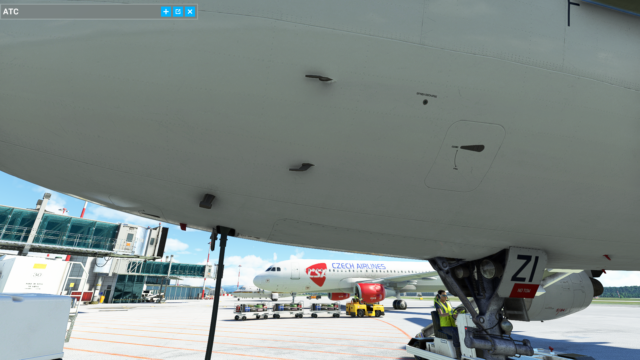
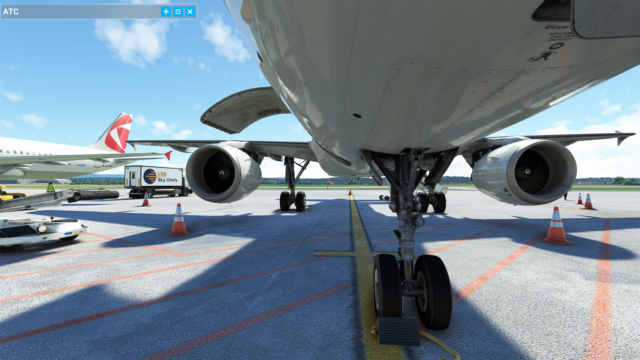
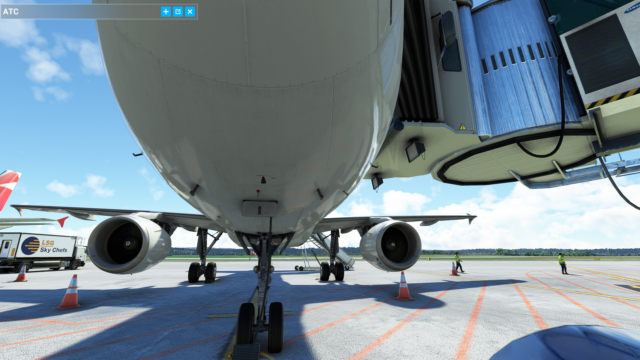
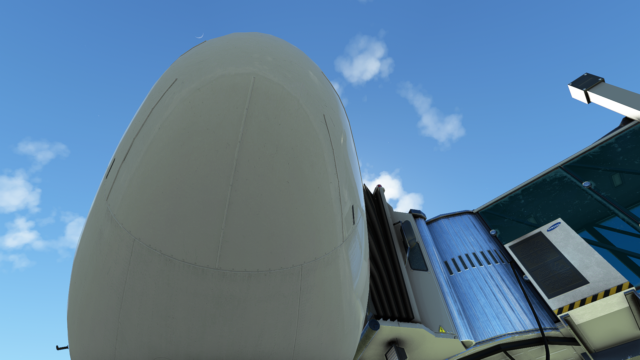
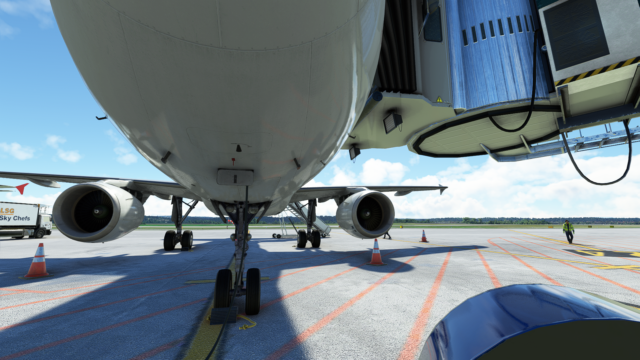
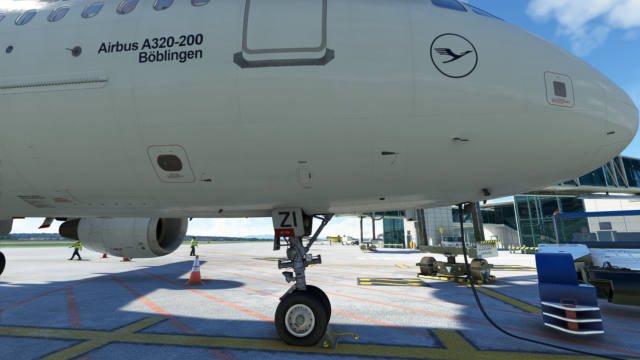
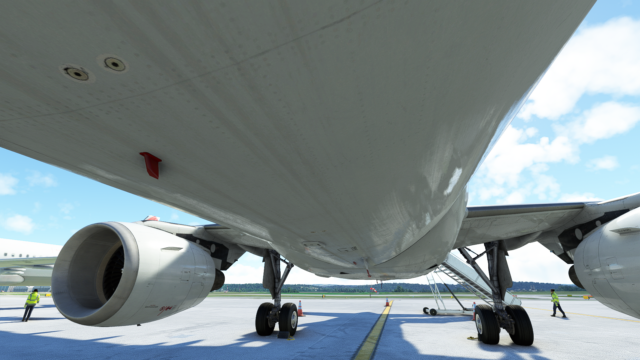
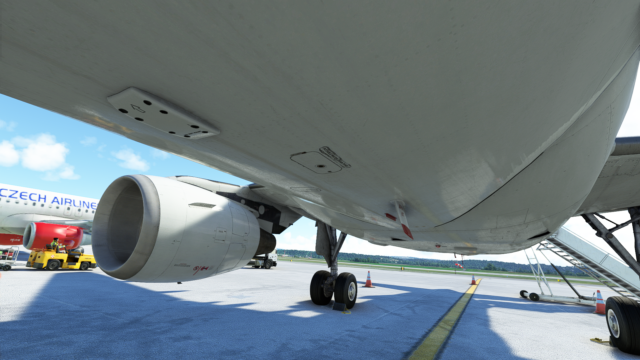
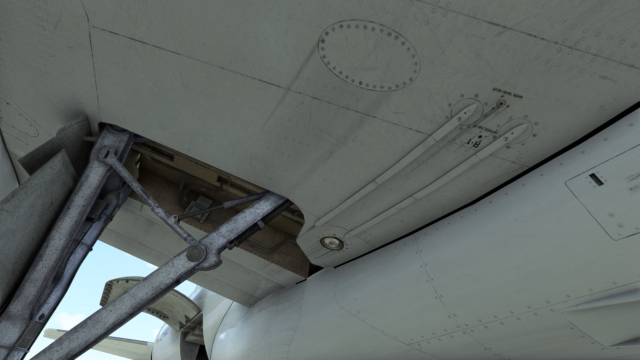
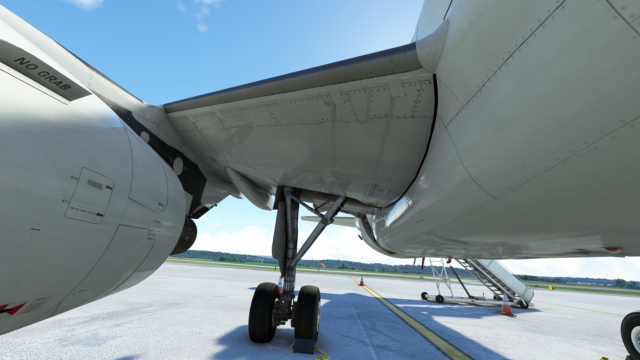
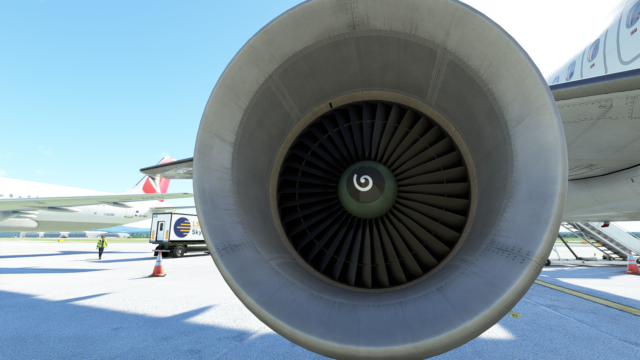
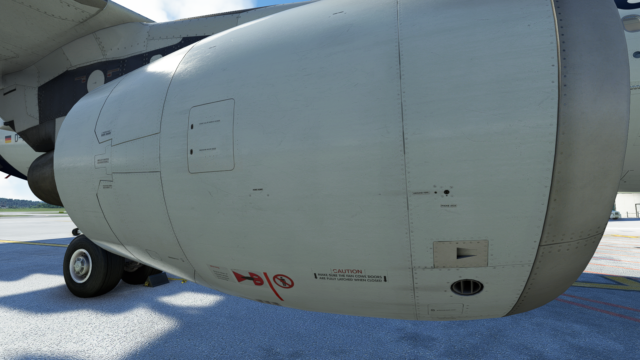
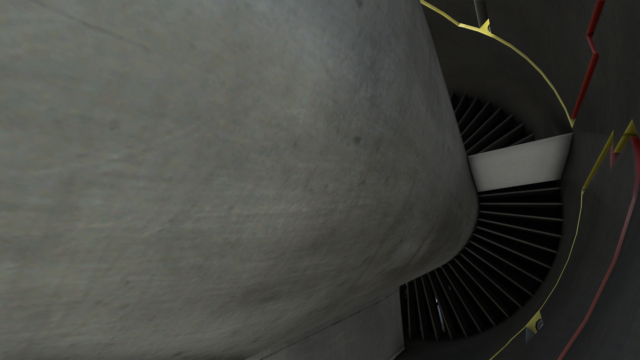
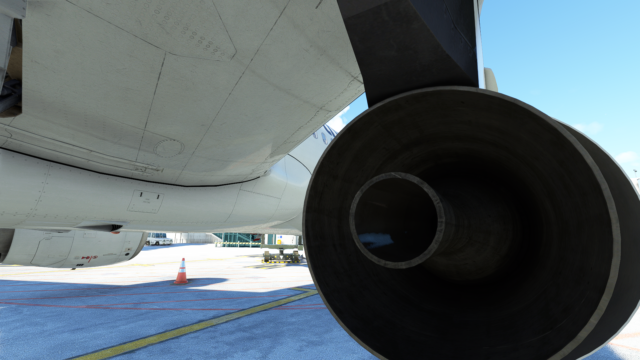
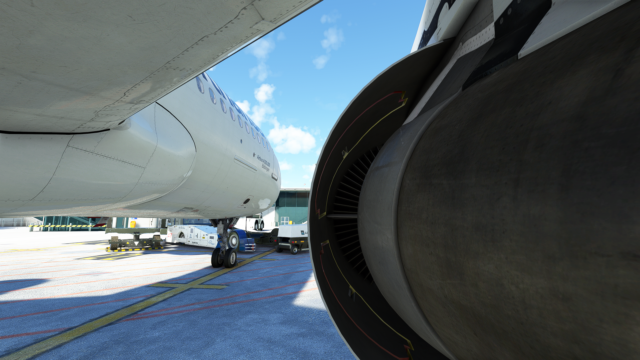
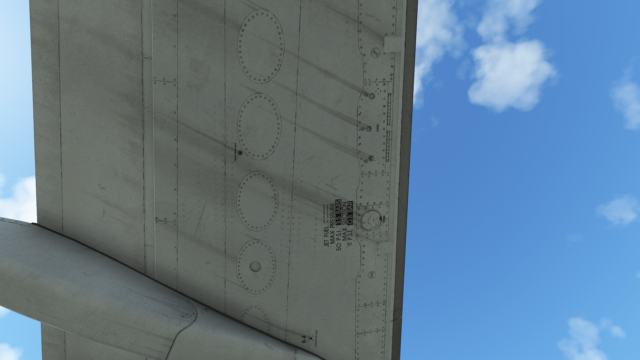
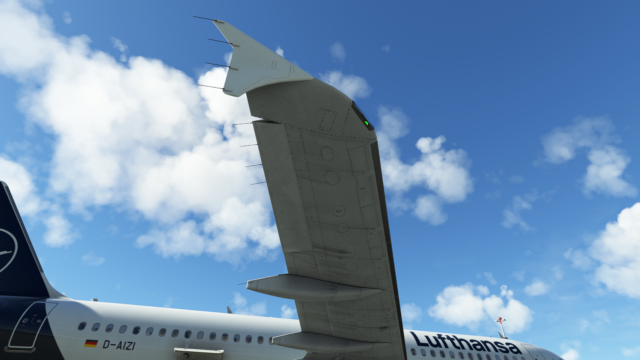
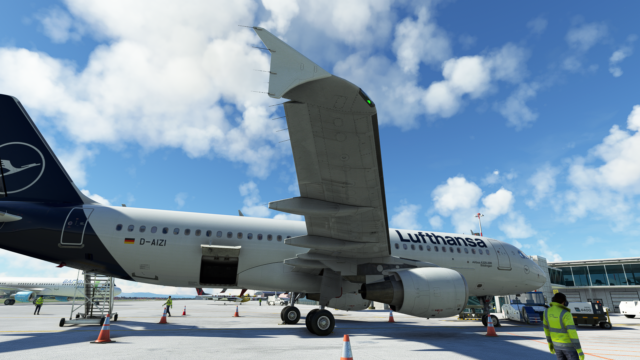
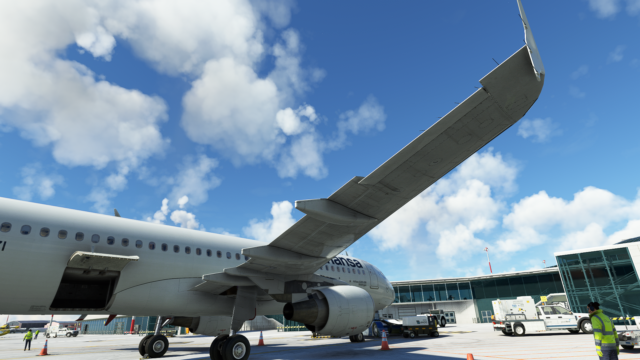
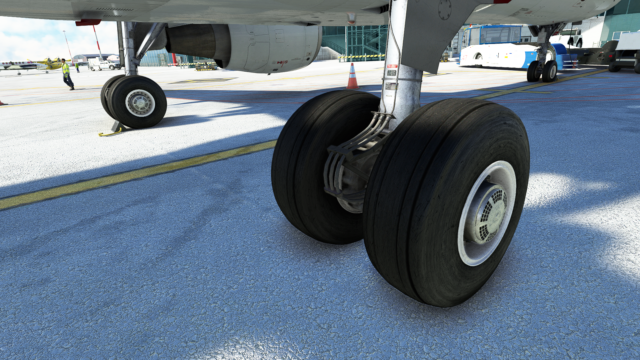
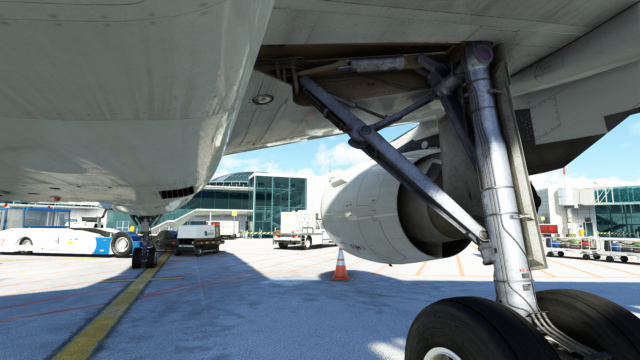
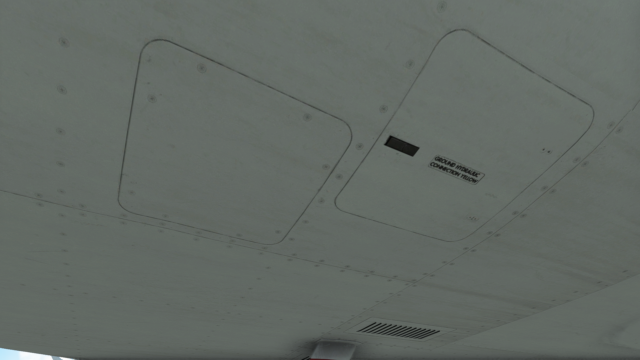
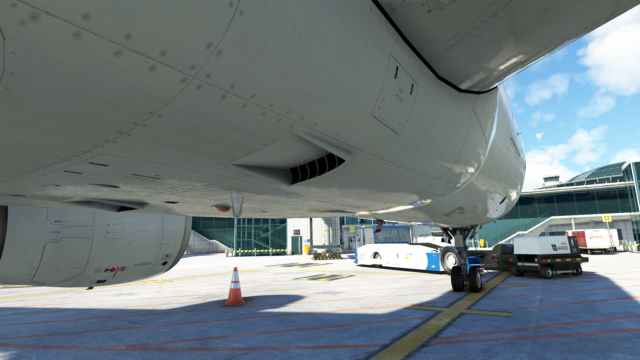
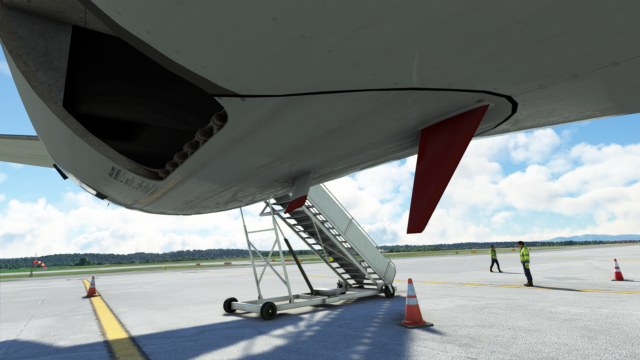
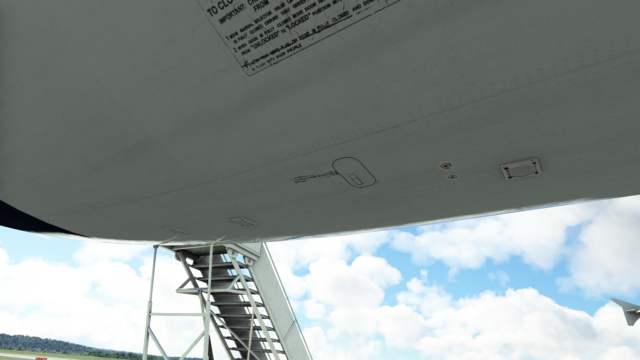
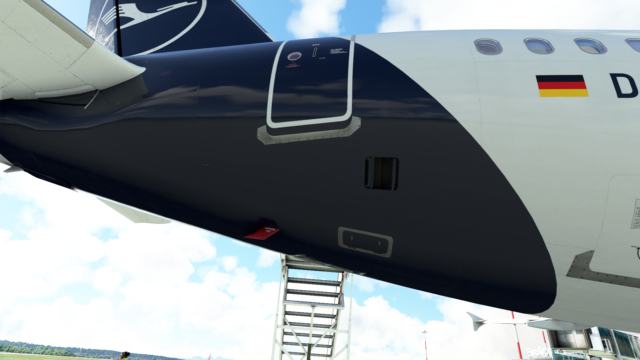
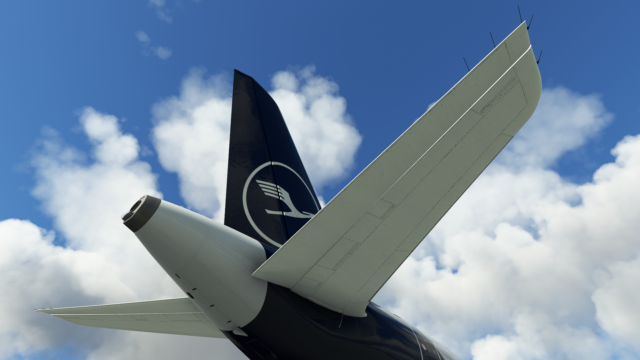
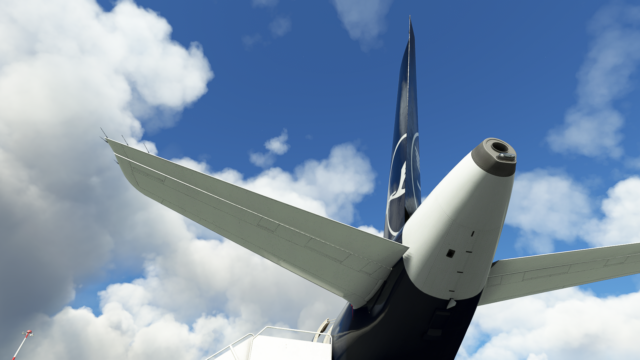
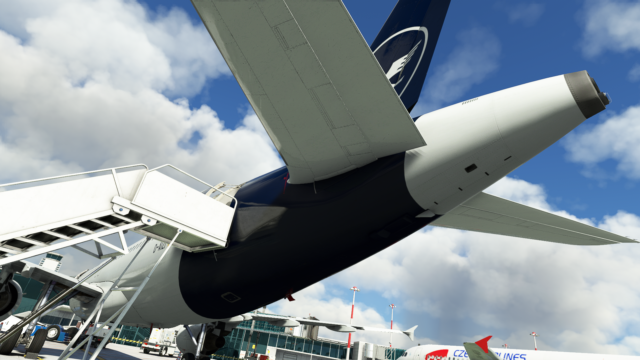
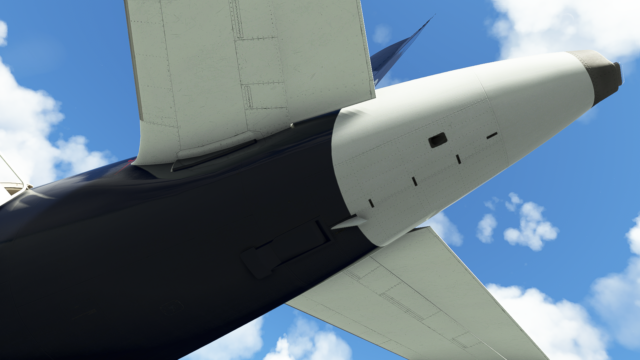
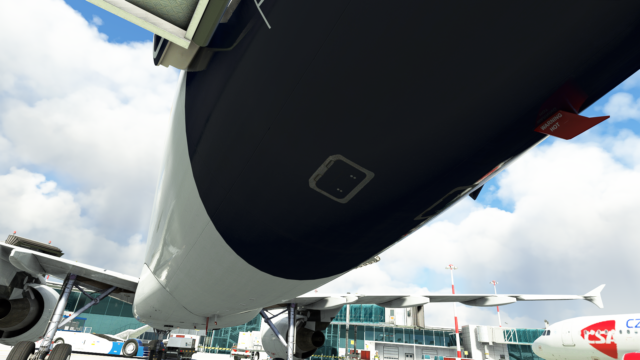
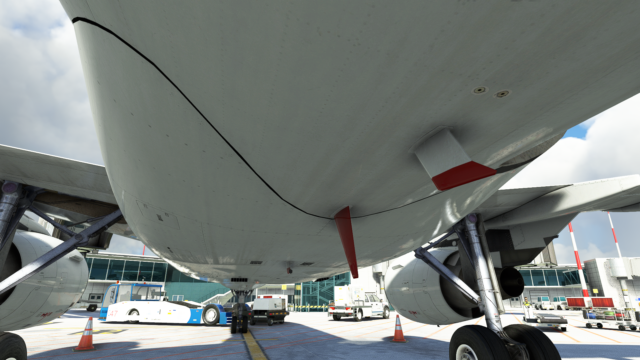
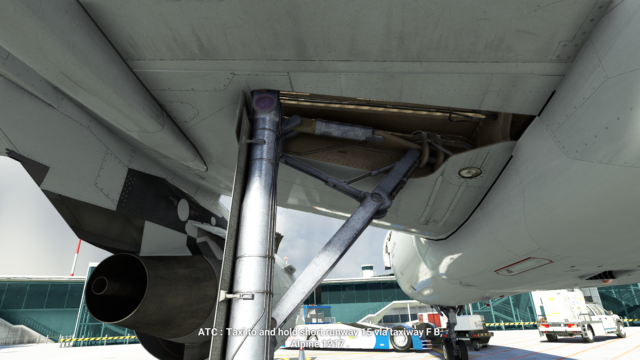
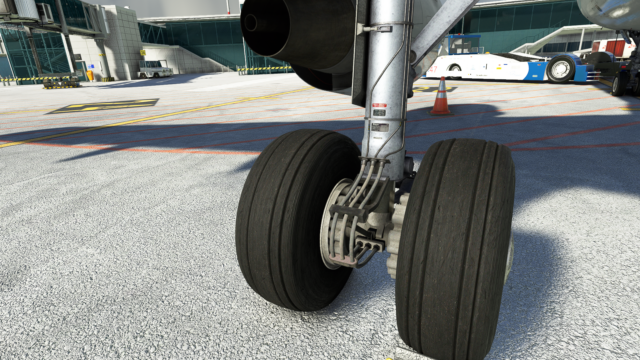
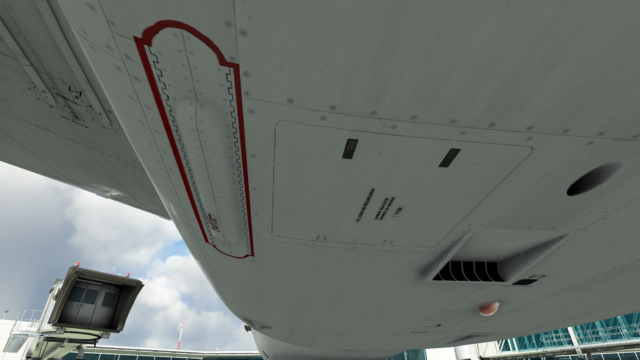
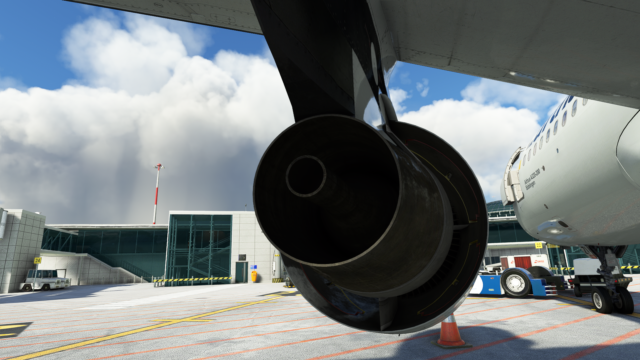
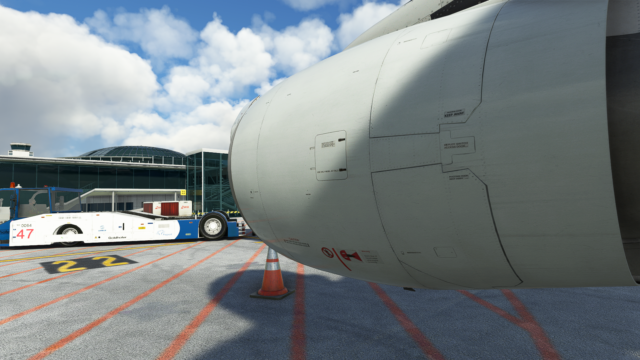
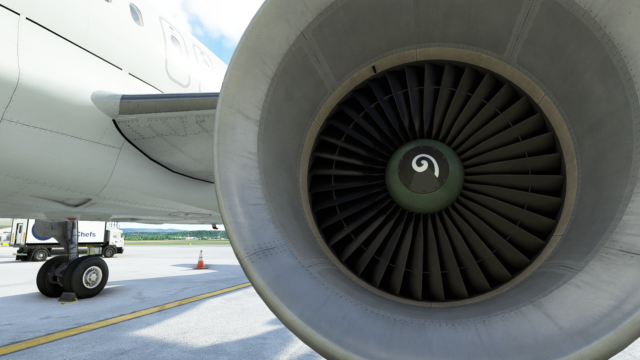
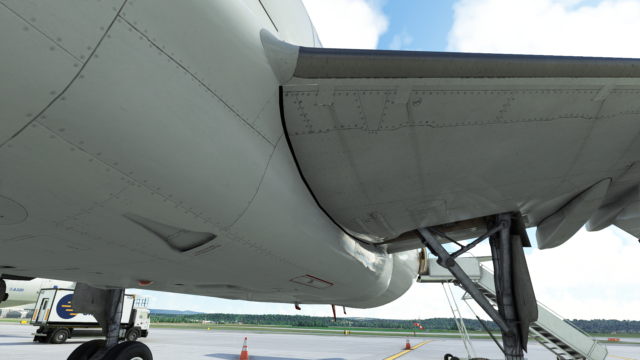
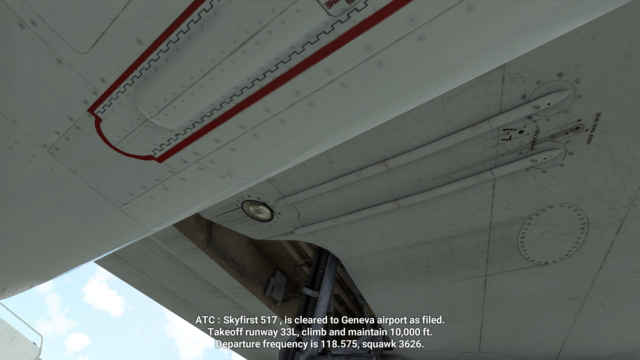
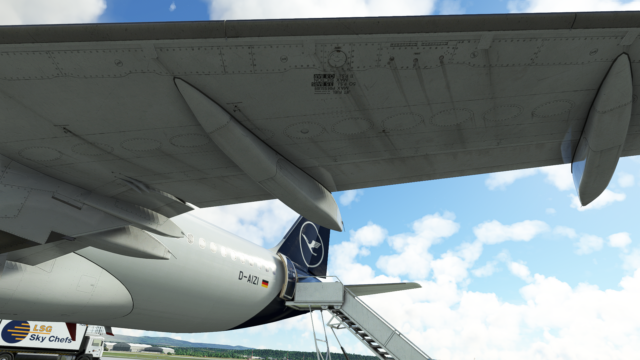
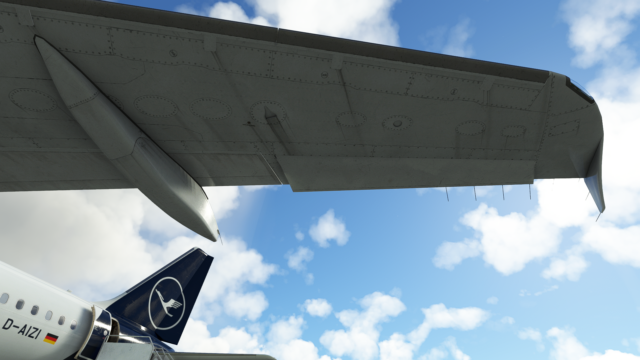
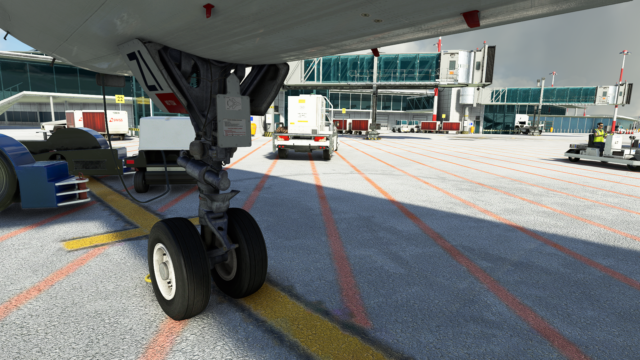
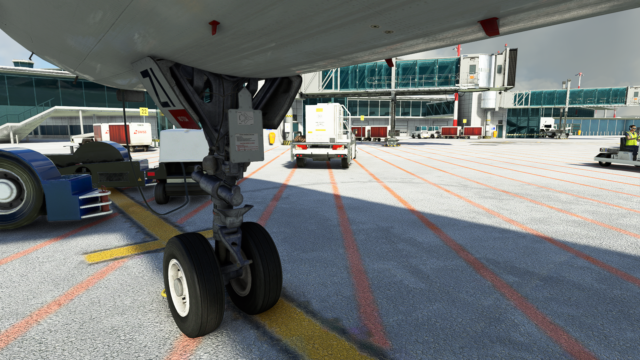
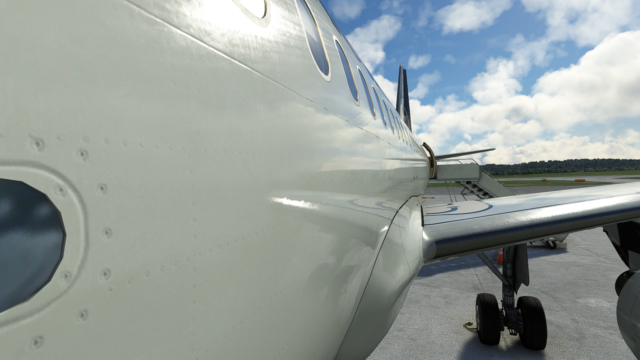
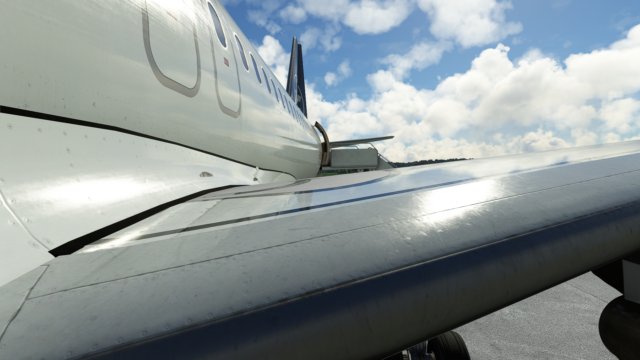
If you want to see a video of the Fenix A320 doing a walkaround, you’ll find it here:
The cockpit
Very good Airbus cockpits have been known in the simulator for a while, the previous landmarks have already been mentioned, such as Aerosoft; FSLabs, FlyByWire. FenixSim goes one better: the CFM-320s have been in use for a while, and it is exactly this atmosphere of wear and tear that the Fenix bus conveys: the knobs are very grabby, the frequently touched switches are a bit bent, used parts of the panels are scuffed, not to say punched. Airbus flight decks that I have seen myself were more neatly spaced, so the Fenix workstation seems a bit aeroflottish or African to me, as if this bird already had at least 20 years under its belt. At least Fenix spares us bread crumbs and coffee residue in the panel cracks, as PMDG once had in the 737. I personally feel more comfortable in the as-new flight deck of the FlyByWire A230NEO, but that is a matter of taste. The Fenix workplace is authentic and realistic, and also pleasantly disrespectful to the “sanctity” of the temple room “flight deck” – here, not only the course of precisely prescribed rituals is celebrated, but also work, sweat, swear, and breathe deeply again. You can almost “smell” it, so detailed is Fenix’s cockpit modelled, right down to the sensuous materiality of the seat covers, and nowhere flat textures, but even the most insignificant fuse panels in 3D – and functional! A second time: W O W !
Both workstations have an EFB, and via it, panel states and cockpit configurations can be varied – either you stick to the respective historical model of the selected livery, or choose between analogue and digital standby instruments and the option for an analogue HSI. In addition, doors, chocks, stairs, ground power etc. can be controlled via the EFB, but above all the entire flight planning: it loads flight plan and charts from Simbrief (and Navigraph, if applicable), loads weather data, calculates performance data, displays loading, refuelling and even a passenger list, i.e. pretty much what you actually need an EFB for. Enormously practical: you can easily outsource the EFB to an external device (tablet, smartphone).
The real highlight in the cockpit, however, is the MCDU, which I have never experienced in such detail in any other simulated Airbus – after all, Fenix’ Airbus is backed by professional software for Airbus simulation, namely ProSim AR. This is no longer a flight game, and it needs training. The MCDU fetches most of the data from the various sources on “request” and then reads them in, but I didn’t succeed with all of them at first go. Moreover, Aerosoft’s after-work Airbus didn’t bother me with getting into the details of loadsheet, centre of gravity, fuel and thrust calculations. In any case, because of the detailed flight planning, it is worth getting a free Simbrief account and integrating it here. If you want to fly Airbus “like the real thing”, you will hardly be able to get around the actuality and above all the charts that Navigraph provides. But of course you can also do without.
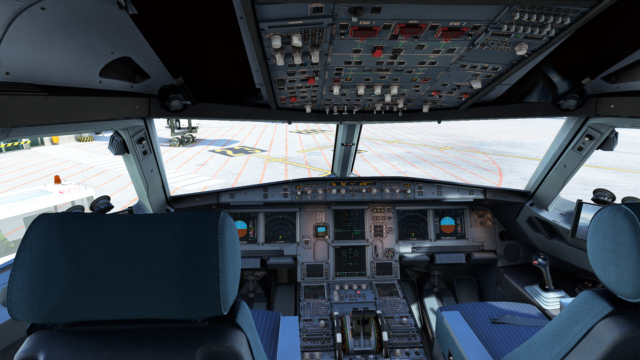
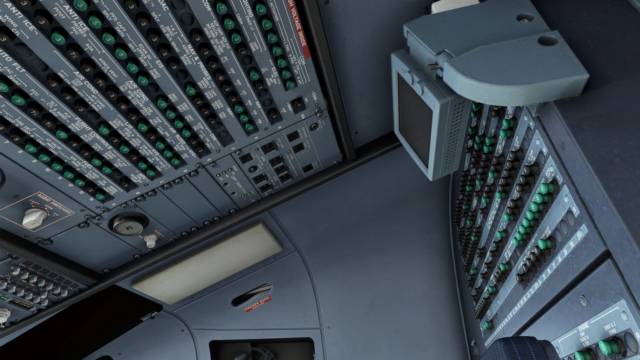
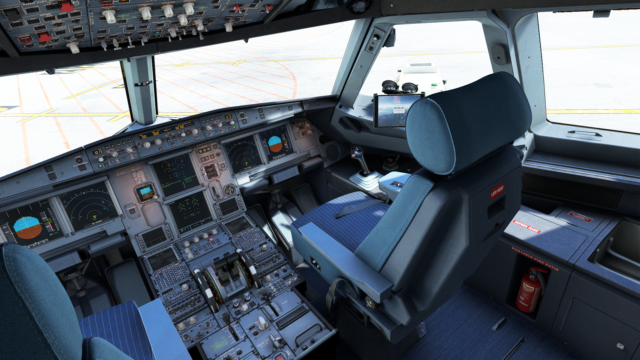
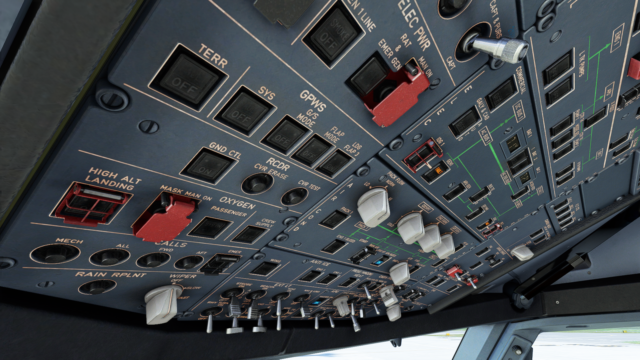
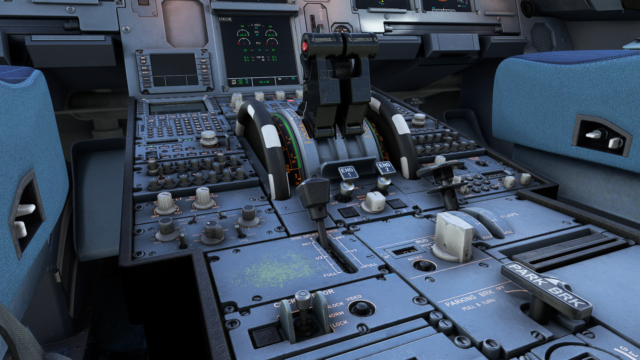
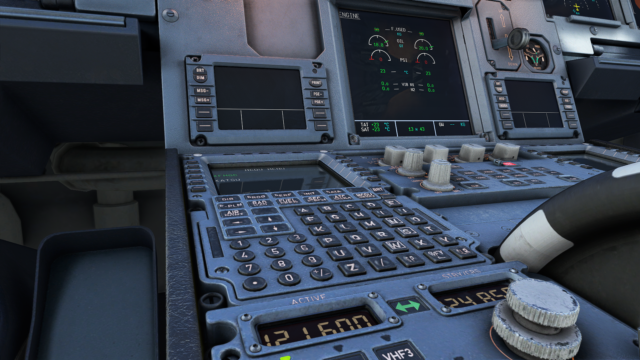
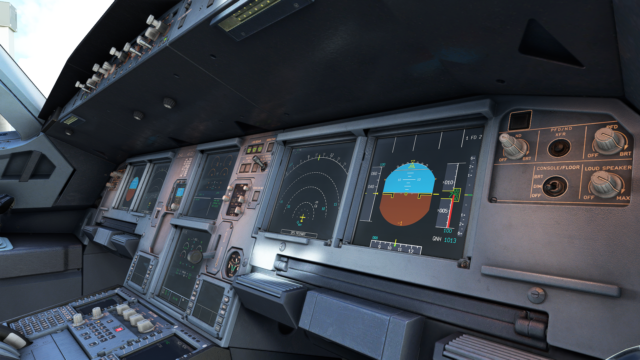
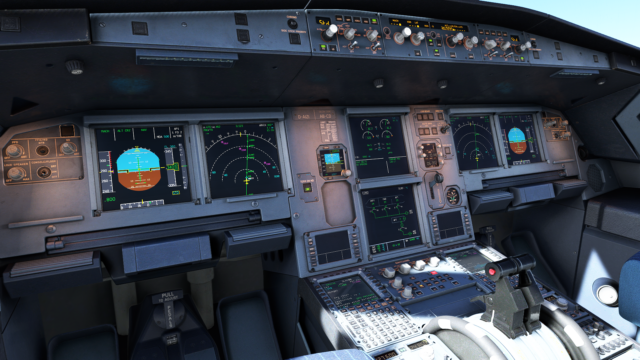
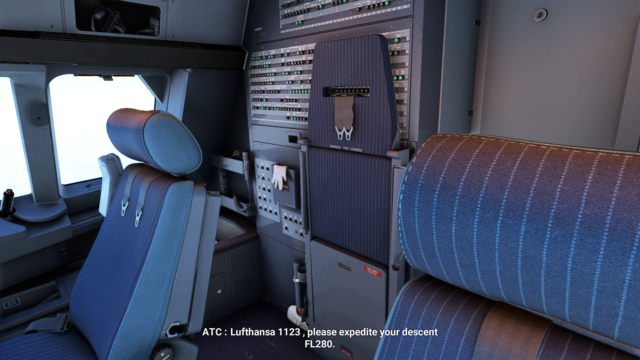
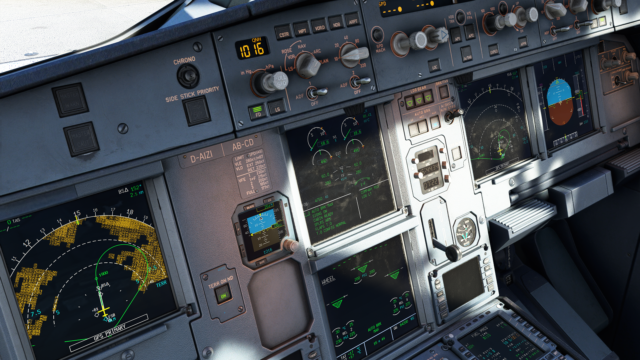
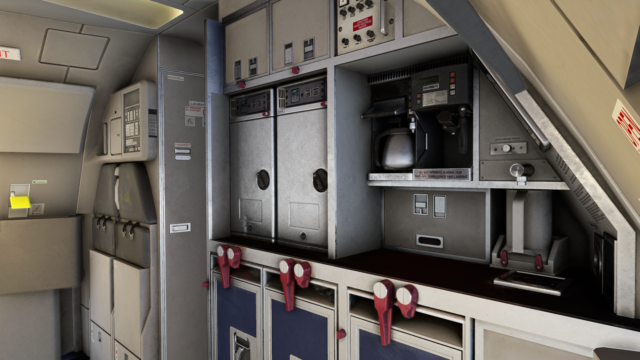
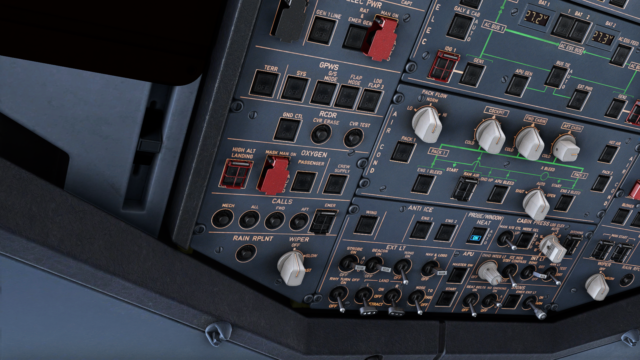
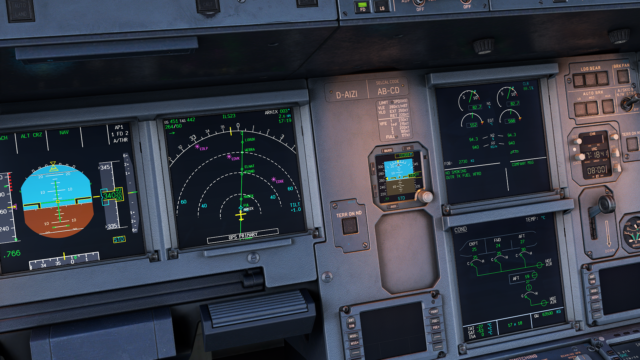
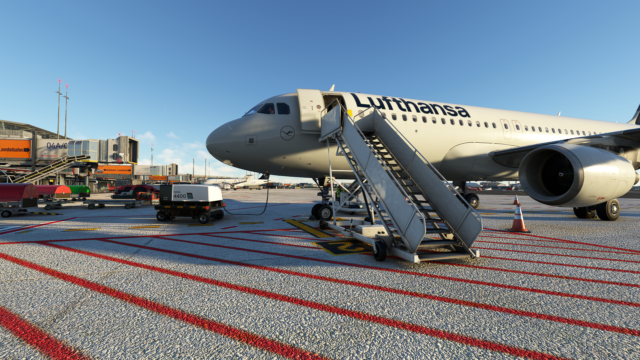
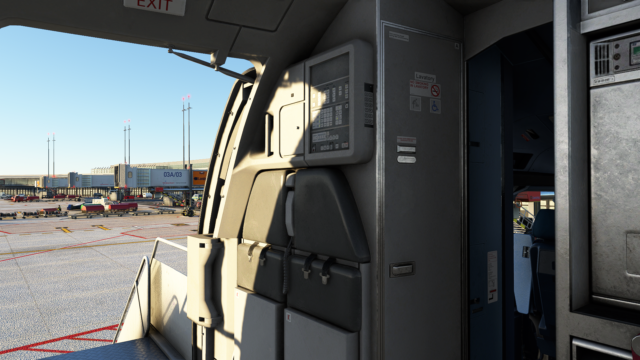
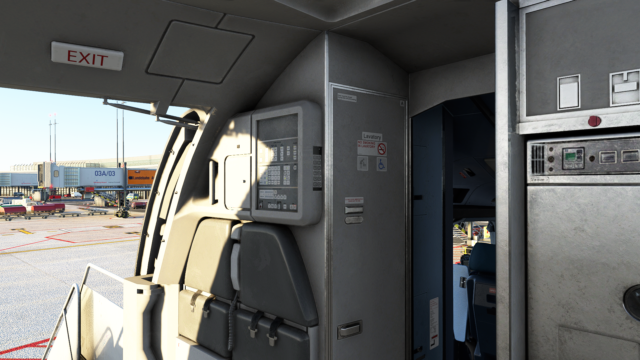
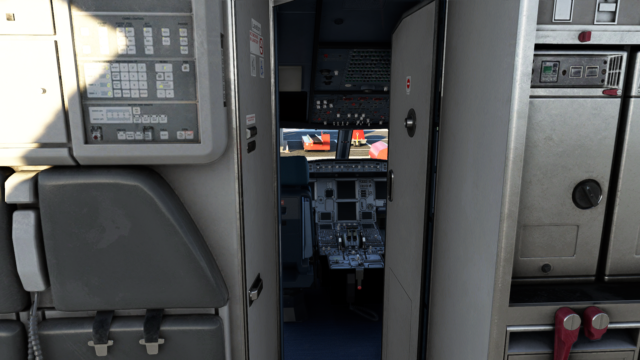
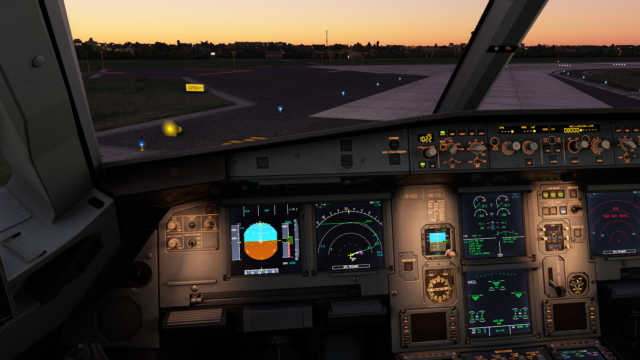
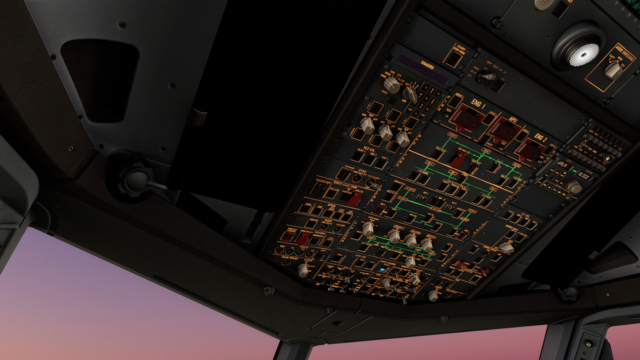
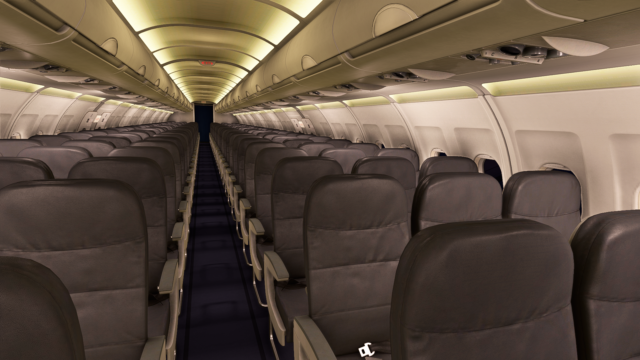
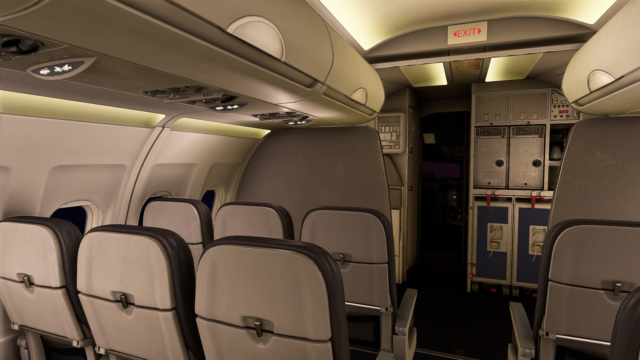
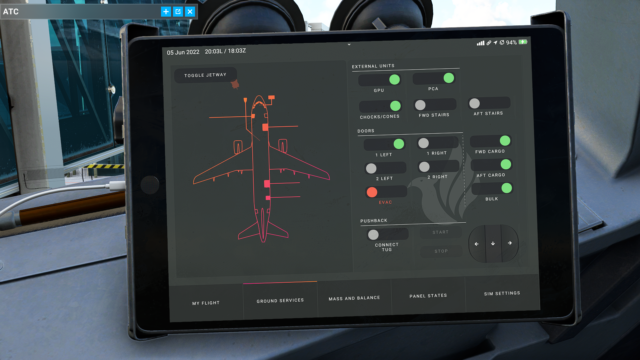
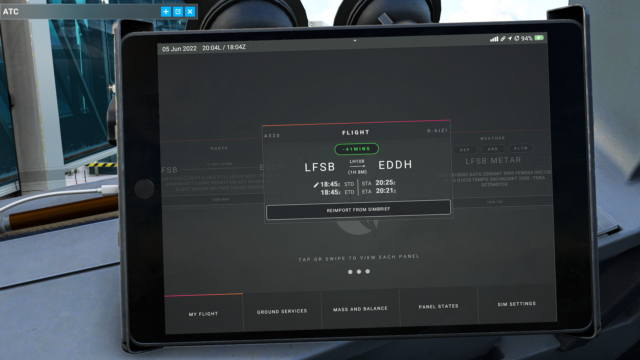
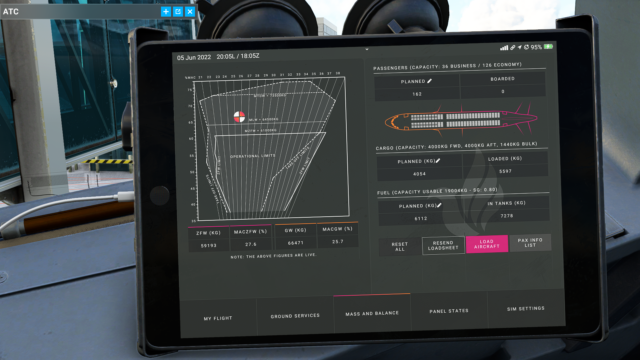
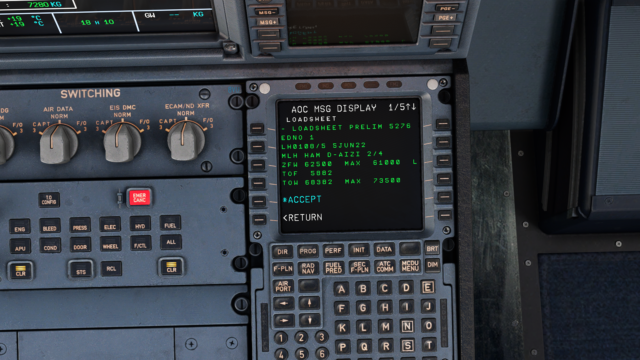
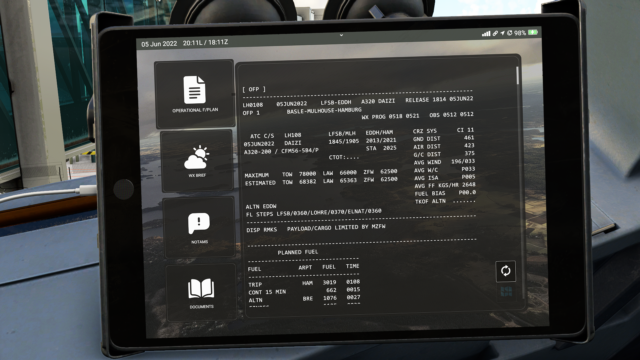
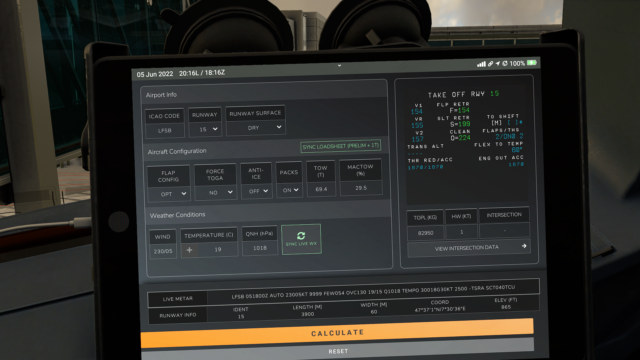
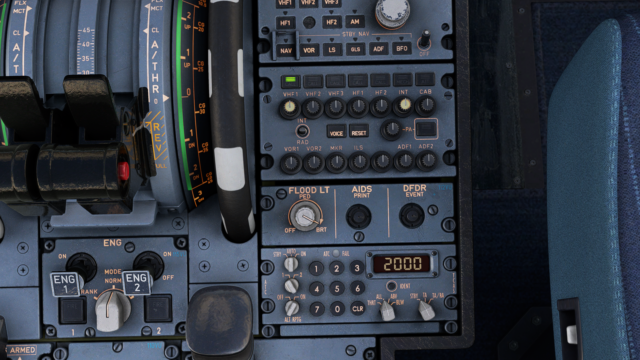
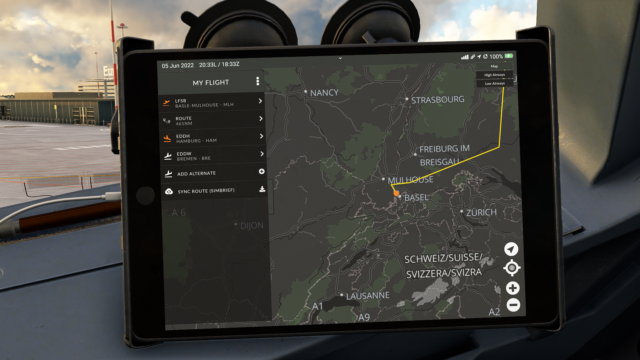
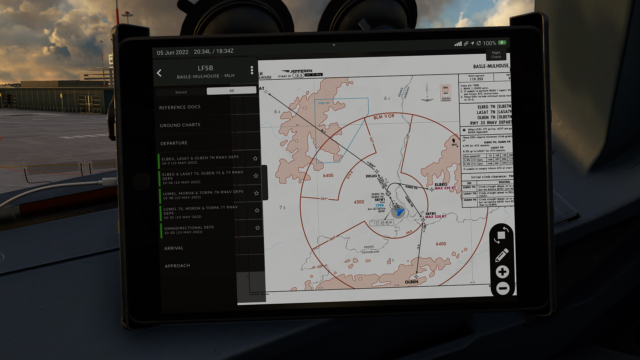
Even at night the flight deck seems extremely realistic, all lights can be switched and dimmed “like in real life”, of course also the screens, so that you have a really good view outside for night landings. What’s surprising – the logo lights don’t work, everything else does. I find the flashlight a bit sparkly, but the winglights in particular are well done.
Also worth mentioning – the windows can be opened (with various effects on the ears) and, as in the real Airbus, can only be closed again if you know “the catch”. The sunshade is animated and also blinds the view to the outside, but unfortunately does not cast a shadow on the panels, whose lettering can hardly be read in the bright sunshine at FL340 due to blending. Instead, you can see finger smears on the screens in the slanted sunshine … an effect that surprisingly increases the immersion.
So the Fenix’ Airbus cockpit doesn’t look like an “animated 3D computer graphic”, but sensuously real! I’m curious to see what other details I’ll notice in the coming weeks!
And a word about the soundscape: it’s also very well done and mega realistic!
Also designed is the cabin (with classless charter seating), on the one hand enormously detailed (with working lighting, reacting no-smoking and seatbelt lights), three-dimensional “kitchen” instead of just flat textures, on the other hand in an older version without screens in the backrests. For fun, you should walk through the cabin, you have never experienced one so detailed in a flight simulator. For take-off and landing you can deactivate it to save fps, at the gate and in cruise it can be switched on again.
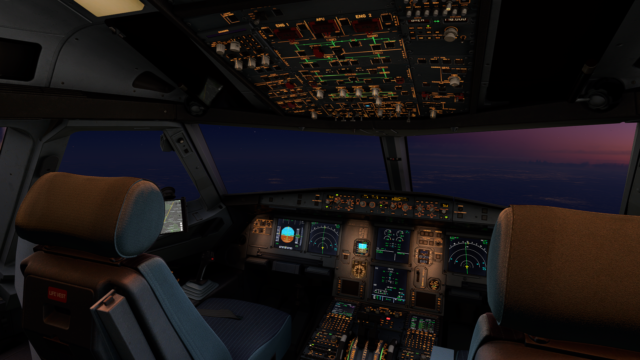
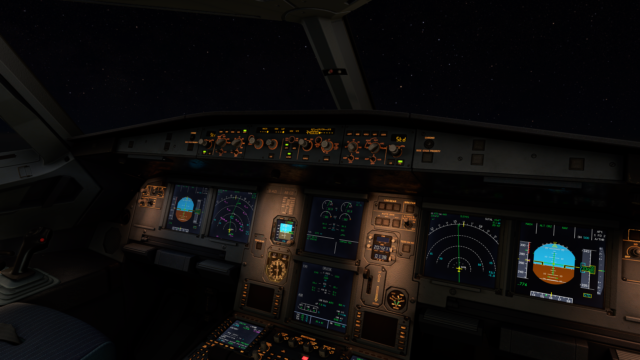
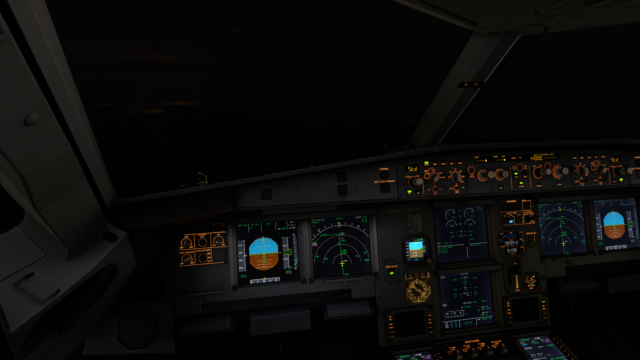
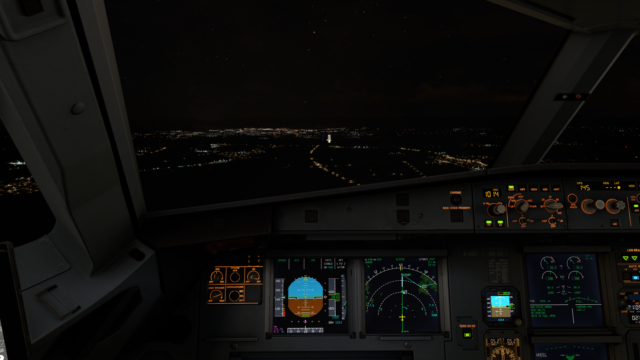
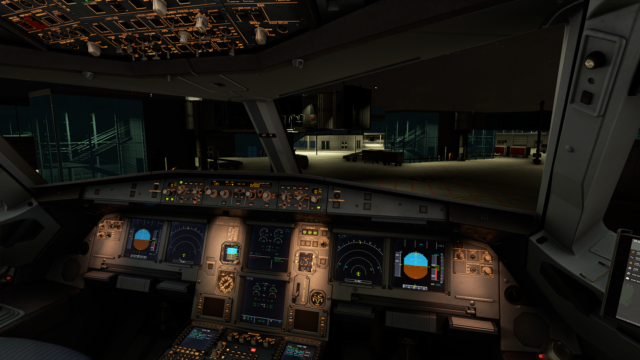
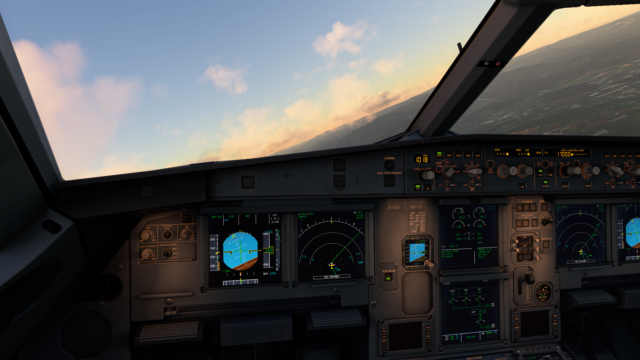
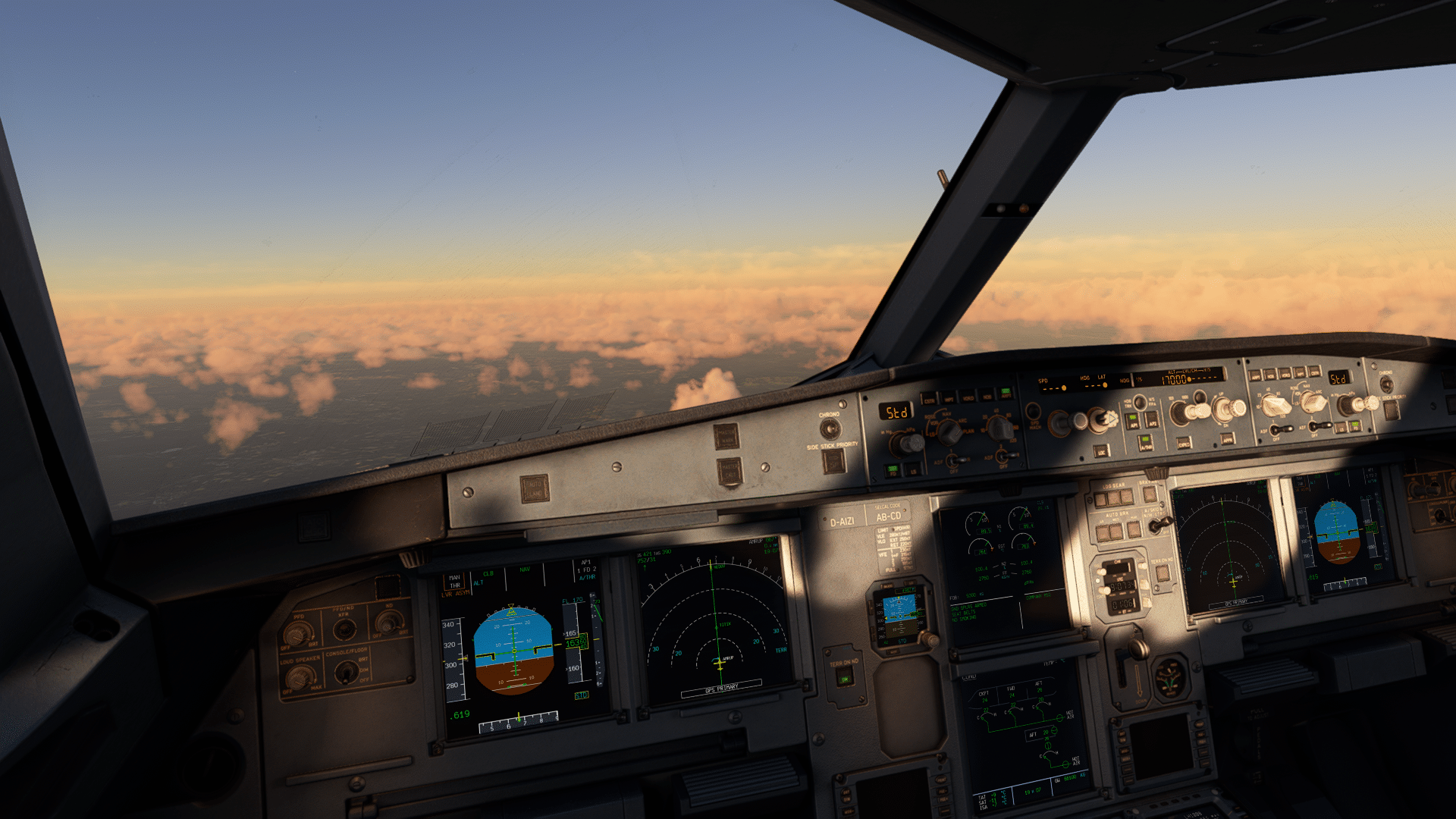
How it flies
This bird is not for an evening VFR jaunt around the local mountain and back home to the hangar, but built to go the distance. We’ve been waiting for this at MSFS for almost two years, so we place ourselves at a gate at EuroAirport Basel Mulhouse Freiburg for the evening flight to Hamburg and back again at night.
Actually EasyJet flies the route (and a Swiss Easyjet is in the liveries), but Lufthansa also serves German cities from Basel, and both with A320s.
In Fenix’s Airbus, you can – no, must – practice “7P”: Proper Preflight Planning Prevents Piss Poor Performance, otherwise you can’t get the Airbus up. So a Simbrief flight plan is made; passengers are counted and baggage weighed; weather is read into the EFB; fuel and performance are calculated; everything is read or transferred into the MCDU – this all takes time, especially at the beginning. Approvals obtained; settings made on the MCP; by the way, the transponder always shows “2000”, although the code is correctly set up in the MSFS after confirmation; pushback; engines started up; flight controls and brakes checked – the control surfaces react much more slowly to inputs than I know from Aerosoft or FlyByWire – more realistic simulation of the control hydraulics? And off we went. Fenix’ Airbus behaves like an Airbus until then … But when taxiing (with my rudder pedals) it seems to jam now and then, sometimes it goes late into straight position, which causes a few embarrassing swerves on the way to Runway 15. Takeoff configuration set, release fetched, lined up, thrust run up to 50%, brakes released, thrust advanced to flex position. The first time you call up the Fenix bus you have to calibrate your own thrust and flap controls with the Fenix airbus (the MCDU has extra pages for this), then in operation it’s a mixture of looking and listening to make sure you engage the thrust levers correctly, it’s a bit fiddly. The click spots on the panels are also tightly circled and not always easy to handle, practice makes perfect.
While the bus picks up speed, the engines roar in the familiar, unmistakable CFM sound, which I have never heard so accurately on a simulated Airbus, great! Subjectively, the take-off distance seems a bit longer than with other Airbuses (more realistically simulated?), the take-off is easy … 500ft above ground I hand over to the autopilot. Fenix’ A320 does a wonderful job: flies smoothly down the SID, climbs as and where it should, keeps to the speeds, simply great. When reducing the thrust on Climb, pay attention to the audible clicks again, otherwise there will be asymmetrical propulsion.
On the first two thirds of the route, there is little difference for me to the previous Airbuses in the simulator – climb up to the cruising altitude, fly off the legs, compensate for the wind, maintain speed. Unfortunately, there is still no weather radar in MSFS, but the TCAS in the Fenix Airbus works as it should. Strange are the “freezes” of which I have had one per flight with the Fenix bus: either in late climb, cruise or in descent, the screen and sound freeze, the PC no longer reacts to any command. This can last several minutes, with one or two short fractions of a second in between, when the PC twitches again. Then suddenly everything is fine again. In the meantime, however, the plane has covered some distance, has climbed or descended according to plan. Once, after the PC woke up again, the bus went into a spin and crashed.
Descend management is a complex subject, and even the simulated versions of the Airbus flight management system have their shortcuts, shortcomings and dysfunctions. In order not to bother myself with it, I have so far handled it intuitively as an Airbus after-work pilot, which is certainly rather unprofessional, but did not detract from the fun: with time you figure out how to get smoothly through the STAR and into the final without rough interventions. Now Fenix seems to me to open up a new dimension of realistic re-flying of real procedures. Today, as always, I help myself with manually entered descent and get along well, helped by the green dot, which tells me the respective altitude in the descent path, the autopilot orientates itself to it, finally I enter the STAR and finally the ILS approach to the 23 in Hamburg, which Fenix’ autopilot manages cleanly without any glitches. And for the first time in MSFS I experience … Jerking!
Full up settings in MSFS, Simwing’s lavishly complex EDDH scenery and Fenix’s Airbus are too much together. I’m not talking about a “slide show”, but the usual smooth action in MSFS falters. The last 1000ft above ground I fly myself as usual … the bus “feels good in the hand”, follows the controls willingly, the first landing is not perfect yet (the last time I landed with 10 to 15 fps was in FSX), but from the second, third one has the feeling for stick and thrust lever reactions with the Fenix bus. Only the full reverse position sticks with me something, but that can be due to imprecise calibration, or also the jerkiness of the system. I’ll play around with the settings of the Airbus and the MSFS to make it run smoothly, but maybe deactivating the cabin is enough!
Slow down, breathe a sigh of relief, taxi out and to the gate …. WOW, that was fun! The best Airbus flight I’ve ever had in MSFS, despite the jerkiness and after only a short time of getting used to it (or getting used to FlyByWire). This Airbus is first class!
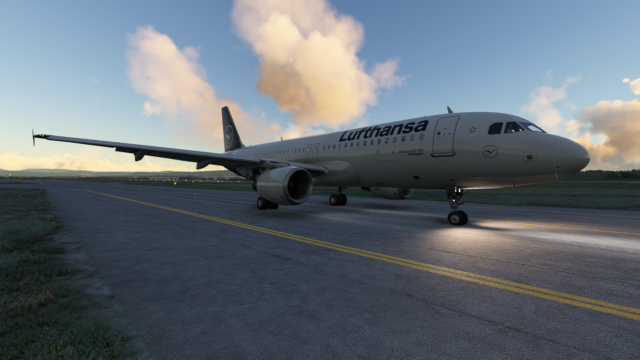
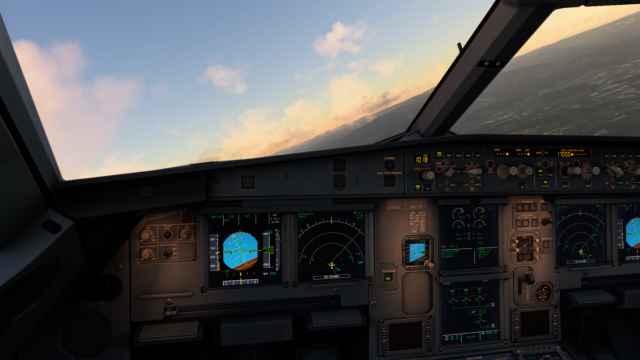
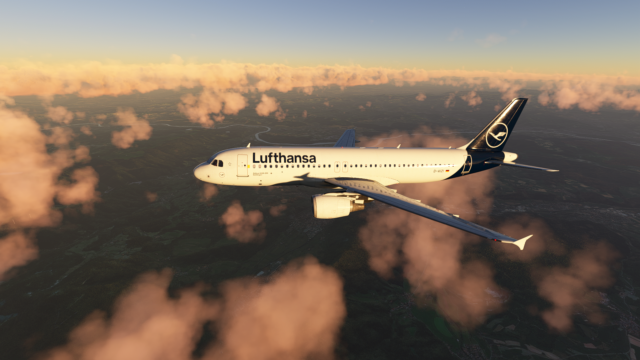
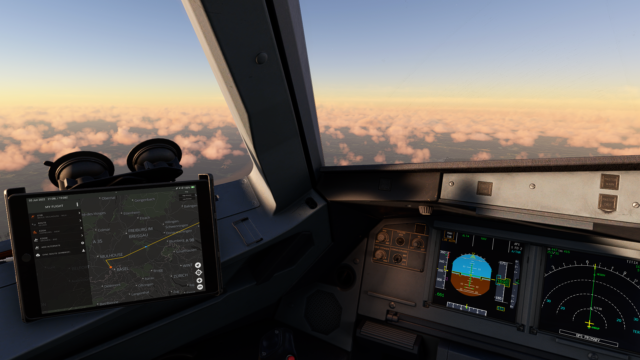
At dusk I set off for the way back, the preflight planning is already going better, I can see through more and more functions of EFB and MCDU, which is fun. This time I get the 05 to take off, and with the cabin deactivated nothing jerks in Hamburg, neither when taxiing nor when taking off. Voilá … if that was it? That would be an easy tweak. In the climb I activate the cabin again, a few thousand feet above ground there are no more performance problems. As we climb and cruise south it gets darker and darker, the lights and screens in the cockpit can be dimmed individually and appropriately, which not only looks nice and cosy, but also provides a good view outside. After 40 minutes it’s time for the descent again, I deactivate the cabin, get clearances for descent and turn the commands into the MCP, the autopilot steers downwards oriented on the green dot on the altitude display and also flies the somewhat angular STAR without any problem, picks up the glide path and f ollows it like a tractor beam from the Enterprise. I take over the last 1,000ft by hand again and manage a clean night landing, only the thrust reverser sticks again – I’ll test it further to see what the problem is. Back to the now night gate in LFSB … Engines off, jetway docked, the Airbus shut down for the night … all is well! It’s been a long time since IFR flying was so much fun!
Unfortunately, the documentation is very sparse, there is no manual. Fortunately, the community has already put a whole series of video tutorials on the net, among them, by the way, many real A320 pilots who are quite enthusiastic about the Fenix bird (and don’t have to study manuals, they know the real bus from the FF):
Systems
(Patrick)
Here I take the baton on the last few meters, with a check of system modelling. What is particularly interesting here, from the point of view of an engineer who also deals a little, rather marginally, with functional safety and redundancies: The fly-by-wire system, which I would like to describe to you briefly and concisely before I start some experiments with the aircraft. I found a summary of the behavior here.
In normal operation (“Normal Law”), the Airbus 320 is essentially protected against operating errors (for example, too large an angle of attack at too low a speed) by the so-called Flight Envelope Protection. This is usually done by a whole series of computers (actually real-time controllers): “Flight Augmentation Computer”, the FAC 1 and FAC 2 (standby) control the rudder; “Elevator Aileron Computer ” ELAC are responsible for the control surfaces, together with the “Spoiler Elevator Computer” SFC (3x). For their work they need reliable information about speeds, attitude and so on from the “Air Data Inertial Reference Units” (of which there are three, none of which should differ greatly from the others). If this is NOT the case, then the pilot reverts to the so-called “Alternate Law”, where only rudimentary protection is available, for example lowering the nose if the speed is too low. If this is not enough, the glider can actually stall. If it is not enough for the “Alternate Law” because more computers fail, the glider reverts to the “Direct Law”, the inputs from the flight stick go unfiltered to the control surfaces, and manual trimming is necessary. Further on, the plane then degrades to mechanical backup only, as direct control is possible via the rudder pedals and the trim wheel; the side stick has no function, and this is also only possible with hydraulic pressure (i.e. in the worst case with the Ram Air turbine). Why am I explaining all this to you? Because all this is not part of the normal operation, it is not available in Aerosoft’s smaller Airbus simulations. And I find the extent to which this is simulated here correspondingly exciting.
How do we go about this now? According to the system description, it should be sufficient to switch off one or two of the ADIRUS to force the aircraft into “alternate law”. Alternatively, it should be sufficient to switch off both FACs, then the digital rudder control is gone, but this is certainly less disturbing than if we switch off ELAC and SFC – then the control surfaces could no longer be moved. We then enter Direct Law by extending the landing gear – from now on we trim by hand!
By the way, for Normal Law we are talking about a roll rate of about 15°/s with full deflection of the sidestick, which fits pretty well (4 seconds from -30° to +30°), up to 33° the roll angle is maintained, between 33 and 66° (absolute values in each case, so it applies to both directions) the plane returns to 33°, and more than 66° should not be possible. I measure slightly lower roll rates, see the following diagram:
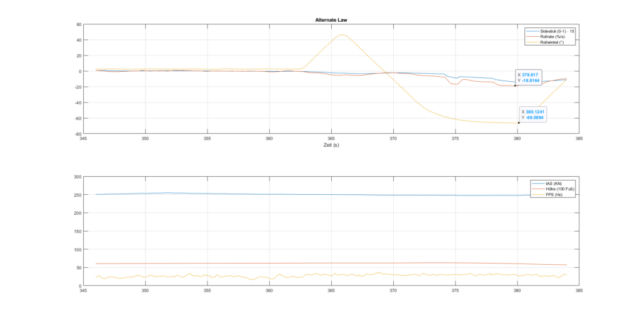
For my tests, I went to Arvidsjaur in Swedish Lapland; there is little going on here in the summer, and besides, the framerates tend to be good due to the lack of cities. At an altitude of about 10,000 feet I switched off the first ADIRU – a warning message appears, but the flight behaviour does not change yet – even with two ADIRUs a take-off would still be allowed according to the Minimum Equipment List. Switch off a second ADIRU, and after a short time the expected warning messages appear, and the confirmation: We are in the “Alternate Law”. Switching on the ADIRUs leads us – in each case after a short waiting time, which I assume to be correct due to various self-tests and monitoring cycles – back to the Normal Law.
Switching off both flight augmentation computers also leads us to the Alternate Law, with corresponding error messages for the rudder (of course, the rudder control is also running on the FAC). In both cases the autoflight system (autopilot, autothrust) switches off automatically; without FAC at least autothrust and the limitation of the roll angle to 66° still work (see following diagram), a single FAC is enough to restore full autoflight function, but not for automatic landings, and the appropriate error messages for individual rudder actuators are then also there – all this corresponds to what I expected after this report. I am thrilled, for that alone it is worth switching from the “small” buses to this complex simulation model.
How does it go into Direct Law now? For landings Alternate Law reverts to Direct Law, so it is sufficient to extend the landing gear without both FAC, and unimagined flight manoeuvres are possble (shown in the following diagram: a complete roll, the yellow graph is the roll angle, which then switches to +180° at -180°, whether this also works in real life I cannot say, maybe one or the other captain reading along knows more 😉 ). The roll rates are now also no longer limited, I have up to 44 °/s and thus about three times as much as in “normal law”!
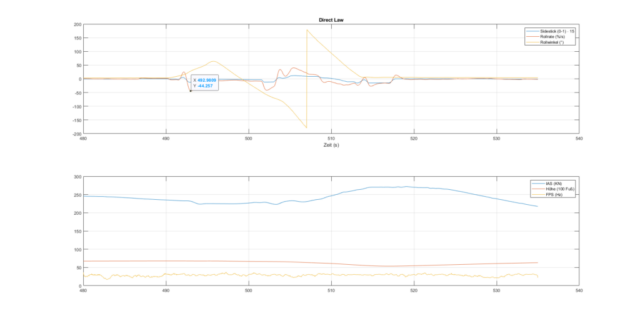
And how does it fly now? On my way back to Arvidsjaur (I had lost my way a bit – simply press the DIRECT button in the FMGC to ESNX) I flew manually in Alternate and Direct Law. I didn’t notice the missing trim after landing gear extension, but in general the Airbus is not as smooth in the air without all the attitude controls (remember: the sidestick is actually just a setpoint generator for roll rate and pitch rate!), I moved the sidestick more (good to see in the upper of the two graphs in the following picture as a red line) – just like I would do in a Boeing on approach. And of course (I was flying without autothrust) concentration on airspeed is now important. Also to be seen: during the landing, the frame rate (in virtual reality!) was slightly below 30 FPS.
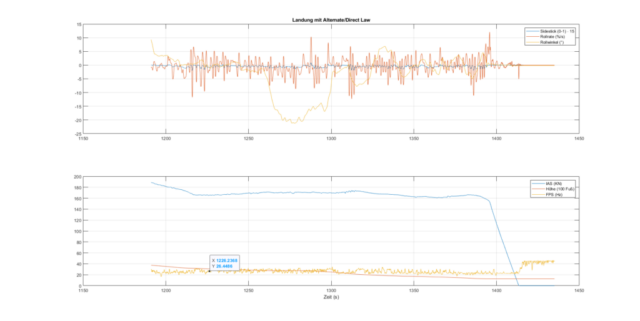
What I have not tried out for you is the flight behaviour in “mechanical backup”, because that is probably no longer any fun.
In addition to the actual fly-by-wire, the systems also include the independent autopilot with its control behaviour (which setpoints for the fly-by-wire flight controller are derived from the trajectory planning) and the FMGC (planning of the trajectory, i.e. path curve and speed), which is also independent of it. Since the menu structure of the FMGC with its two display units is basically well documented, I would expect differences to the previous simulations only on the level of errors and inconsistencies in the real aircraft; however, I cannot really verify this without information. I would rely on the judgement of the real pilots who, according to Michael’s statement (see above), are very enthusiastic.
That means: From my point of view, the systems have been modelled plausibly and their failure behavior corresponds to what I had expected. And with this, this Airbus opens the door to re-flight incidents where this Atari aircraft, which is actually so easy to operate, quickly becomes very complex. For me, this is a new dimension in Airbus simulation (I can’t say what it’s like in the FS Labs Airbus, which I skipped).
Virtual Reality
While I’m holding the baton, a word about virtual reality: slightly decreasing framerates are not nice on a normal screen, but in virtual reality they are a real problem. With the cabin switched on, I’m moving at pretty much exactly 20 FPS, which is no fun. Without the cabin and in a quieter environment (Lapland, see below), I get 30 to 40 FPS, and just under that when landing, which is still okay.
If you are still using Oculus Rift CV1 and/or affordable graphics cards, you won’t have much fun with the tablet to control the simulation, there is almost nothing recognisable – so settings should better be made in 2D. And: the touch controllers unfortunately don’t work at all, you have to rely on the mouse.
My conclusion: When everything is up and running, the flight is planned, the plane is configured and the cabin is switched off, VR is possible and of course preferable to any screen – until then, it’s a bit awkward. But maybe something is still happening.
(\Patrick)
Conclusion
Visually, acoustically and aeronautically, this is the best Airbus ever programmed for a Microsoft Flight Simulator, and at a fair price! Fenix shows what is possible in MSFS and sets the new benchmark. If you want to deal with the Airbus at study level, you won’t find a better product for MSFS. It is not intended for a quick after-work flight without much training, but those who already have Airbus experience, even with Aerosoft, will quickly find their way around, a joyful learning curve is guaranteed – and a fantastic simulation experience that has not been available before. Only the high system load is a minus, in combination with complex airports even good systems get a little weak at the knees.
Information
| Pro | Contra |
| -Enormously detailed, very close to reality – Acoustically also a blast – The most realistic A320 simulation for the MSFS at an unprecedented level – User-friendly despite great complexity – Fair price! | – Resource-hungry – Almost no documentation – Less suitable for virtual reality due to performance and lack of controllability with touch controllers |
| Testsystem | |
| Developped by: Fenix Simulations Price: Ca. 60 € Purchase: Fenix Sim only | Michael: IntelCore i5-10600K CPU @ 4.10GHz GeForce RTX 3070, 8 Gb Windows 10×64, 16 Gb Diverse SSD Patrick S. AMD Ryzen 5 5600X @ Stock Speed Oculus Rift CV 1 GeForce GTX 1080, 8 Gb Windows 10×64, 32 Gb Diverse SSD |
Translated from Geman to English with the help of deepl.com
Dr. Michael Kalff, Dr. Patrick Seiniger







